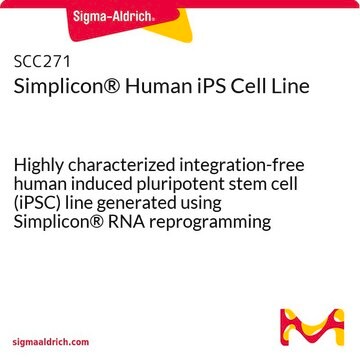66540174
UNEWi021-A
Human iPS Cell Line
Synonyme(s) :
EBiSC iPSC Line, Human iPSC, Induced Pluripotent Stem Cell Line, iPS Cell, iPSC
About This Item
Produits recommandés
Source biologique
human dermis (fibroblast)
Méthode de reprogrammation
Sendai virus
Description
age (80-84)
Fabricant/nom de marque
EBiSC™
Sexe
female
Mode de croissance
adherent (pluripotent)
Technique(s)
cell culture | stem cell: suitable
Maladie(s) pertinente(s)
none
Conditions d'expédition
dry ice
Température de stockage
−196°C
Description générale
The EBiSC stem cell bank is a collection of human iPS cells available to academic and commercial researchers for use in disease modelling and other forms of stem cell research. The initial collection has been generated from a wide range of donors representing specific disease backgrounds and healthy controls. EBiSC has established many routine procedures for collecting, expanding and characterizing human iPS cell lines. The stem cell bank includes iPSC cell lines derived from neurodegenerative diseases (Alzheimer′s Disease, Parkinson′s Disease, Dementia, Motor Neuron Disease (ALS) - and Huntington′s Disease), eye and heart diseases, and lines from healthy control donors for age and sex matching.
Origine de la lignée cellulaire
University of Newcastle
Description de la lignée cellulaire
Primary cell type: Fibroblast of dermis
Primary cell developmental stage: Adult
Passage number reprogrammed: P4
Reprogramming method
Vector type: Non-integrating
Vector: Sendai virus
Gene list:
KLF4
MYC
POU5F1
SOX2
Is the reprogramming vector detectable: Unknown
Other:From the same donor: UNEWi021-B, UNEWi021-C
Characterization
Analysis of Undifferentiated Cells
Marker expression: NANOG(+)SSEA-4 (+)SSEA1 (-)TRA 1-60(+)
Differentiation potency
Ectoderm:
Retinal Pigment Epithelium
In vitro spontaneous differentiation
In vitro directed differentiation
Marker Expressed:Tuj1 (+)
Endoderm: In vitro spontaneous differentiation
Marker Expressed:AFP (+)
Mesoderm: In vitro spontaneous differentiation
Marker Expressed:SMA(+)
Microbiology / Virus Screening
HIV 1: -
HIV 2: -
Hepatitis B: -
Hepatitis C: -
Mycoplasma: Negative
Sterility
Inoculation for microbiological growth: No Contaminants Detected
Mycoplasma: Not Detected
Viability: Viable post-cryopreservation
Genotyping
Karyotyping
Passage number: P10
Cell line karyotype: No clinically significant imbalance was detected
Karyotyping method: Molecular karyotyping by SNP array
Genotyping
STR/Fingerprinting: A 16 allele profile has been recorded and data is available upon request, after cell line purchase.
Liaison
Procédure de repiquage
Passage method: EDTA
Matrix: Matrigel® / Geltrex®
CO2 concentration: 5%
O2 concentration: 20%
Temperature: 37°C
Informations légales
Code de la classe de stockage
10 - Combustible liquids
Classe de danger pour l'eau (WGK)
WGK 3
Point d'éclair (°F)
Not applicable
Point d'éclair (°C)
Not applicable
Certificats d'analyse (COA)
Recherchez un Certificats d'analyse (COA) en saisissant le numéro de lot du produit. Les numéros de lot figurent sur l'étiquette du produit après les mots "Lot" ou "Batch".
Déjà en possession de ce produit ?
Retrouvez la documentation relative aux produits que vous avez récemment achetés dans la Bibliothèque de documents.
Articles
We offer answers to frequently asked questions and a large collection of cell culture media, supplements, and bioactive small molecules used to control the cell fate of human iPSCs.
Notre équipe de scientifiques dispose d'une expérience dans tous les secteurs de la recherche, notamment en sciences de la vie, science des matériaux, synthèse chimique, chromatographie, analyse et dans de nombreux autres domaines..
Contacter notre Service technique








